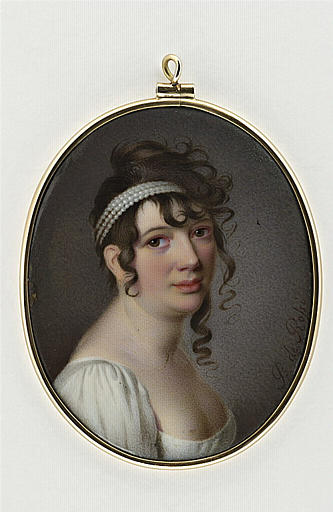Most of us are very aware, today, that our perception of what is ‘beautiful’ is affected by how the media shows things, and by the appearance of celebrities etc. Whilst the form of media available was rather dramatically different in the Regency era, the result was not so different.
Celebrity had a huge effect in Regency times – what someone important wore would soon become all the rage. Fashion magazines existed, and, like those of today, tended to show ladies as models, who were rather slimmer than average. Even throughout the Napoleonic wars, French influence on fashion was strong, and the most popular modistes were often of French background.
Most interesting though, is what we discover when we compare the fashion plates with portraits painted in the era. Portraits were often painted in such as way as to show the subject in a more favourable light than perhaps their actual appearance provided. Which makes them an even stronger indication of what was valued as beauty…..
 Generally the women who were famous for being ‘diamonds of the first water’ in the Regency era were not the super slim things you might expect. If you looked at them today, you would probably see them as short and rather plump. Why would that be considered beautiful ? Well, at the simplest level, a certain plumpness is a good indication of wealth – you are not starving, you can afford enough food to be plump!
Generally the women who were famous for being ‘diamonds of the first water’ in the Regency era were not the super slim things you might expect. If you looked at them today, you would probably see them as short and rather plump. Why would that be considered beautiful ? Well, at the simplest level, a certain plumpness is a good indication of wealth – you are not starving, you can afford enough food to be plump!
Poor women were likely to be almost universally thing and bony, in that time, so to be plump was a way to show your wealthy status. being over fat was still seen as a negative, but where the boundary between ‘just right’ and ‘too much’ lay was very different from today. And, being plump produced another result, which suited the fashion of the day.
Although the Regency era corsets / stays, were more flexible and less limiting of movement than those from the era before, or just after, they were still designed to constrain and lift the breasts, so that the breasts were ‘nicely displayed’, framed by the rather low necklines and ‘off the shoulder’ styles of the ball gowns of the day. A plump woman usually had breasts rather more suited to that, than a thin woman!
This focus on plumpness as beauty also reflected the evidence of wealth in a more subtle way. Young ladies of the aristocracy did not work. They did not even do anything particularly strenuous, beyond sometimes riding a horse, and walking. Poor women worked – often back-breakingly hard work. So, as an aristocratic young woman, it was rather easy to get somewhat plump – you were not exactly encouraged to do much exercise! So, again, being a little plump was a clear sign of your place in the social order, and of your wealthy desirability.
So…. think about it…. in that era, would you have been perceived differently, from how you are today? And would you be happy about it?
Image courtesy of http://jeannedepompadour.blogspot.com.au/2012/06/miniature-portraits-hans-holbein.html
Being Portrait of a Lady 1810 by Pietro de Rossi

Leave a Reply